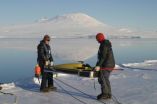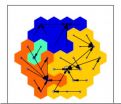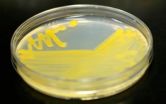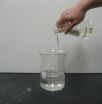(Press-News.org) Researcher Walker Smith of the Virginia Institute of Marine Science, College of William and Mary, has been conducting shipboard studies of biological productivity in Antarctica's Ross Sea for the last three decades. This year he's letting underwater robots do some of the work.
Smith and graduate student Xiao Liu are using a two-year grant from the National Science Foundation to deploy and test a free-swimming underwater glider in the frigid waters of the Ross Sea near the U.S. McMurdo Research Station. The grant also funds efforts by fellow VIMS professor Marjorie Friedrichs to use glider data to help improve computer models of the Ross Sea's physics and biology.
Smith deployed the team's glider—SG503, also know as the Ice Dragon—for its first mission on November 29, 2010. He and colleagues, including investigators from Old Dominion University, launched the 114-pound vehicle through a whale breathing-hole, and then directed it into the open waters of the "polynya" that forms each austral summer when seasonal sea-ice melts from the Ross Sea.
The launch, at a latitude of 77°S, is the most southerly glider deployment ever. A short (and unintentional) jog off course also made it the first-ever glider to successfully dive beneath the Ross Ice Shelf.
The Ice Dragon glider in the waters of the Ross Sea.The glider has now—as of January 19, 2011—completed 783 dives to depths as great as 700 meters (2,330 feet), traveling a total of 1,402 kilometers (871 miles). It is scheduled to continue yo-yoing back and forth across the Ross Sea polynya until the researchers retrieve it in early February.
Each of the glider's dives lasts about 120 minutes, during which sensors on its fiberglass hull measure water temperature, salinity, levels of dissolved oxygen, and chlorophyll concentrations (the latter a measure of photosynthesis and phytoplankton abundance). At the end of each dive, the glider flips its tail into the air so that its antenna can send the collected data to researchers and receive guidance for its next dive. Data is transmitted via the Iridium satellite network.
The potential of gliders
Lacking a motor or propeller, gliders zigzag up and down through the water using a set of fins to translate changes in buoyancy into lateral motion. Their top speed is about one-half mile per hour. A small battery powers the buoyancy changes by forcing mineral oil in and out of an inflatable bladder. Moving the battery fore or aft within the hull shifts the center of gravity to control pitch, rotating it from side to side controls roll.
Smith says that gliders bring several potential benefits to ocean research. For one, because they're propelled by buoyancy changes rather than an energy-hungry motor, they can remain in the water for months at a time before needing a recharge (the current world record is a 4,500-mile transatlantic crossing that lasted 221 days, using the equivalent power of just 3 Christmas tree lights). Motor-driven underwater robots are limited to missions of a few days at most.
A glider's small size and simplicity (with only a few moving parts) also makes it relatively inexpensive to own and operate, especially compared to the costs of ship-based ocean research. Smith's glider—developed at the Applied Physics Laboratory at the University of Washington and now sold commercially by iRobot, Inc. (maker of the Roomba© vacuum cleaning robot)—cost $150,000. A single ship-day, including costs for fuel and crew, can run up to $60,000.
Dr. Mark Patterson, head of the Autonomous Systems Laboratory at VIMS and developer of the Fetch autonomous underwater vehicle (AUV), notes that gliders and other AUVs hold great promise for solving one of the oldest problems in oceanography: the fact that "the ocean changes faster than we have the ability to observe."
"Traditional ship-based studies can only provide snapshots of the constantly changing ocean ecosystem," says Patterson. He says "that's like trying to figure out what's going on in a TV series like 'Lost' by watching just one or two episodes per year." By sampling the ocean almost continually for months at a time, gliders allow researchers to better understand and model short-term physical changes and how they influence ocean biology.
Gliders in the Ross Sea
Previous studies by Smith and other polar researchers suggest that short-term physical variations—changes in sunlight, wind speed and direction, and current patterns—play a key role in controlling the magnitude, timing, and duration of phytoplankton blooms in the Ross Sea. These blooms sustain the Antarctic food web, from krill up to fish, seabirds, and marine mammals.
But a comprehensive understanding of how these short-term changes impact the polar ecosystem has so far remained elusive. That's where gliders come in.
"Our glider will help detail the physical and biological oceanography of the southern Ross Sea by sampling the region continuously through the growing season," says Smith. "Given its ability to repeatedly sample specific areas, it holds great promise for resolving short-term and seasonal trends."
Mission & Modeling
During the team's upcoming retrieval mission, which sets sail on January 19, Smith and Liu will first spend several weeks comparing their shipboard measurements of water temperature, salinity, dissolved oxygen, and chlorophyll to those recorded by the glider. That's to ensure that the glider's sensors are still accurately calibrated after more than two months in the water. The retrieval team will be aboard the research vessel Nathaniel B. Palmer.
Friedrichs will feed the glider's high-resolution data into computer models of physical and biological processes in the Ross Sea, with the long-term goal of making model predictions more accurate.
"Current models are difficult to evaluate using data that are appropriate on the same space and time scales," says Friedrichs. "Data collected by gliders over shorter time-scales are what we need to drive the next generation of circulation and ecosystem models. Improving the modeling and predictability of dynamic systems like the Ross Sea is our ultimate goal."
INFORMATION:
VIMS team glides into polar research
Underwater glider sets 2 Antarctic firsts
2011-01-20
ELSE PRESS RELEASES FROM THIS DATE:
Research provides new kidney cancer clues
2011-01-20
Grand Rapids, Mich. (January 19, 2011) – In a collaborative project involving scientists from three continents, researchers have identified a gene that is mutated in one in three patients with the most common form of renal cancer. The gene – called PBRM1 – was found to be mutated in 88 cases out of 257 clear cell renal cell carcinomas (ccRCC) analysed, making it the most prevalent to be identified in renal cancer in 20 years.
The identification of a frequently mutated gene provides new insights into the biology of the disease, which will be critical in the continued effort ...
Mathematical model explains how complex societies emerge, collapse
2011-01-20
The instability of large, complex societies is a predictable phenomenon, according to a new mathematical model that explores the emergence of early human societies via warfare. Capturing hundreds of years of human history, the model reveals the dynamical nature of societies, which can be difficult to uncover in archaeological data.
The research, led Sergey Gavrilets, associate director for scientific activities at the National Institute for Mathematical and Biological Synthesis and a professor at the University of Tennessee-Knoxville, is published in the first issue of ...
Roundworm unlocks pancreatic cancer pathway
2011-01-20
Chapel Hill, NC – The National Cancer Institute estimates that more than 43,000 Americans were diagnosed with pancreatic cancer last year and more than 36,000 died from the disease. Despite advances in genetic science showing that the Ras oncogene is mutated in virtually all pancreatic cancers, scientists have been frustrated by the complexity of the signaling pathways in humans, which make it difficult to pinpoint potential therapeutic targets.
In a study published today in the Cell Press journal Developmental Cell, a team of researchers led by Channing Der, PhD, Distinguished ...
Speeding up Mother Nature's very own CO2 mitigation process
2011-01-20
LIVERMORE, Calif. – Using seawater and calcium to remove carbon dioxide (CO2) in a natural gas power plant's flue stream, and then pumping the resulting calcium bicarbonate in the sea, could be beneficial to the oceans' marine life.
Greg Rau, senior scientist with the Institute of Marine Sciences at UC Santa Cruz and who also works in the Carbon Management Program at Lawrence Livermore National Laboratory, conducted a series of lab-scale experiments to find out if a seawater/mineral carbonate (limestone) gas scrubber would remove enough CO2 to be effective, and whether ...
Science Translational Medicine: 'Creating Hope Act' incentivizes pediatric drug R&D
2011-01-20
Washington, DC — Recent legislative and regulatory actions make great strides toward establishing much needed incentives for pharmaceutical companies and others to develop and test more medications for pediatric rare diseases, including pediatric cancers, according to commentary by experts from Children's National Medical Center. The commentary appears in the January 19 issue of Science Translational Medicine.
"Pediatricians who treat children with serious and life-threatening diseases often find themselves face to face with the inadequacies of pediatric drug development," ...
Small molecules may prevent ebola infection
2011-01-20
Ebola, a virus that causes deadly hemorrhagic fever in humans, has no known cure or vaccine. But a new study by University of Illinois at Chicago scientists has uncovered a family of small molecules which appear to bind to the virus's outer protein coat and may inhibit its entry into human cells.
The results are to be published in the Journal of Medicinal Chemistry and are now online.
Previous studies have shown that small molecules can interfere with the Ebola infection process, says Duncan Wardrop, associate professor of chemistry at UIC and corresponding author of ...
Like humans, amoebae pack a lunch before they travel
2011-01-20
Some amoebae do what many people do. Before they travel, they pack a lunch.
In results of a study reported today in the journal Nature, evolutionary biologists Joan Strassmann and David Queller of Rice University show that long-studied social amoebae Dictyostellum discoideum (commonly known as slime molds) increase their odds of survival through a rudimentary form of agriculture.
Research by lead author Debra Brock, a graduate student at Rice, found that some amoebae sequester their food--particular strains of bacteria--for later use.
"We now know that primitively ...
University of Illinois study confirms glycerin as a feasible feedstuff for swine
2011-01-20
An increased interest in biofuel production and a growing need to find cost-effective livestock feedstuff alternatives has led University of Illinois researchers to further evaluate the use of glycerin in swine diets.
This study, led by U of I graduate research assistant Omarh Mendoza, was published in the Journal of Animal Science and reports that swine diets may include up to 15 percent glycerin and achieve similar performance to a conventional corn:soybean diet.
"Glycerin is not a new product, but little is known about its role as a feed ingredient for swine," ...
A nanoscale rope, and another step toward complex nanomaterials that assemble themselves
2011-01-20
Scientists at the U.S. Department of Energy's Lawrence Berkeley National Laboratory (Berkeley Lab) have coaxed polymers to braid themselves into wispy nanoscale ropes that approach the structural complexity of biological materials.
Their work is the latest development in the push to develop self-assembling nanoscale materials that mimic the intricacy and functionality of nature's handiwork, but which are rugged enough to withstand harsh conditions such as heat and dryness.
Although still early in the development stage, their research could lead to new applications that ...
US Office of Naval Research achieves milestone
2011-01-20
VIDEO:
This is the Free Electron Laser video.
Click here for more information.
ARLINGTON, Va.-Scientists at Los Alamos National Lab, N.M., have achieved a remarkable breakthrough with the Office of Naval Research's Free Electron Laser (FEL) program, demonstrating an injector capable of producing the electrons needed to generate megawatt-class laser beams for the Navy's next-generation weapon system.
The Dec. 20 milestone, which occurred months ahead of schedule, will be the ...
LAST 30 PRESS RELEASES:
Mount Sinai Health system receives $8.5 million NIH grant renewal to advance research on long-term outcomes in children with congenital heart disease
Researchers develop treatment for advanced prostate cancer that could eliminate severe side effects
Keck Medicine of USC names Christian Pass chief financial officer
Inflatable fabric robotic arm picks apples
MD Anderson and SOPHiA GENETICS announce strategic collaboration to accelerate AI-driven precision oncology
Oil residues can travel over 5,000 miles on ocean debris, study finds
Korea University researchers discover that cholesterol-lowering drug can overcome chemotherapy resistance in triple-negative breast cancer
Ushikuvirus: A newly discovered giant virus may offer clues to the origin of life
Boosting the cell’s own cleanup
Movement matters: Light activity led to better survival in diabetes, heart, kidney disease
Method developed to identify best treatment combinations for glioblastoma based on unique cellular targets
Self-guided behavioral app helps children with epilepsy sleep earlier
Higher consumption of food preservatives is associated with an increased risk of type 2 diabetes
NTU Singapore-led team captures first-ever ‘twitch’ of the eye’s night-vision cells as they detect light, paving the way for earlier detection of blindness-causing diseases
Global aviation emissions could be halved through maximising efficiency gains, new study shows
Fewer layovers, better-connected airports, more firm growth
Exposure to natural light improves metabolic health
As we age, immune cells protect the spinal cord
New expert guidance urges caution before surgery for patients with treatment-resistant constipation
Solar hydrogen can now be produced efficiently without the scarce metal platinum
Sleeping in on weekends may help boost teens’ mental health
Study: Teens use cellphones for an hour a day at school
After more than two years of war, Palestinian children are hungry, denied education and “like the living dead”
The untold story of life with Prader-Willi syndrome - according to the siblings who live it
How the parasite that ‘gave up sex’ found more hosts – and why its victory won’t last
When is it time to jump? The boiling frog problem of AI use in physics education
Twitter data reveals partisan divide in understanding why pollen season's getting worse
AI is quick but risky for updating old software
Revolutionizing biosecurity: new multi-omics framework to transform invasive species management
From ancient herb to modern medicine: new review unveils the multi-targeted healing potential of Borago officinalis
[Press-News.org] VIMS team glides into polar researchUnderwater glider sets 2 Antarctic firsts



